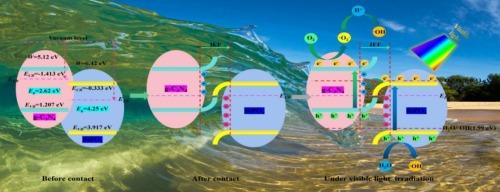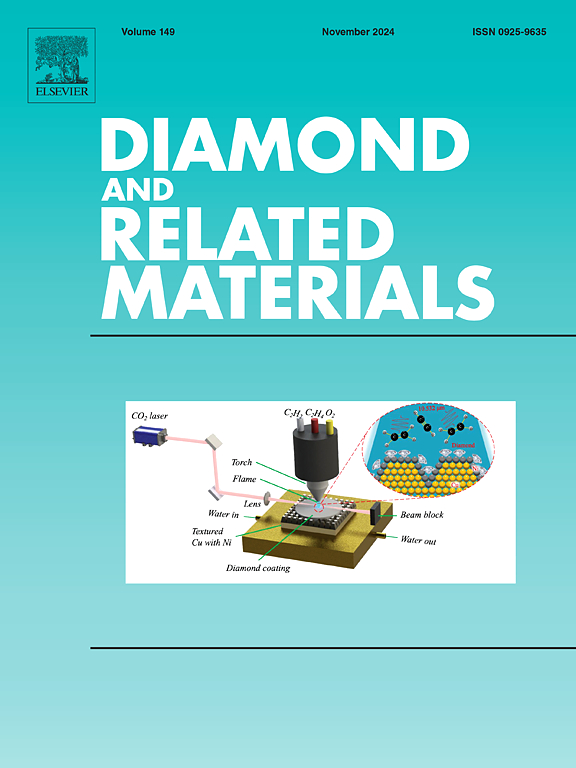增强改性 g-C3N4 异质结光催化降解废水中亚甲基蓝的催化活性
IF 4.3
3区 材料科学
Q2 MATERIALS SCIENCE, COATINGS & FILMS
引用次数: 0
摘要
光诱导电荷载流子的快速重组和较差的光催化降解性能极大地阻碍了 g-C3N4 光催化技术的大规模应用。因此,为了克服 g-C3N4 光催化性能差的问题,我们用 BiPO4 对其进行了修饰,并通过去除亚甲基蓝(MB)对其进行了研究。通过用 BiPO4 修饰 g-C3N4 构建的 S 方案异质结能有效地保留 VB 和 CB 上空穴和电子的氧化还原活性,表现出良好的光催化活性。因此,与纯 g-C3N4 和 BiPO4 相比,改性 g-C3N4 具有优异的光催化活性和高效的光电子-空穴分离能力。由于协同作用,修饰的 g-C3N4 对甲基溴的降解去除率高达 96.7%,明显高于纯 g-C3N4 的 46.3%和 BiPO4 的 3.3%。改性 g-C3N4 的光降解速率常数分别是纯 g-C3N4 和 BiPO4 的 4.8 倍和 43 倍。经过 5 次循环后,改性 g-C3N4 对 MB 的去除率仍高达 92.9%,这表明改性 g-C3N4 具有出色的稳定性和可回收性。结合 LUMO 和 HOMO 分析,研究了改性 g-C3N4 的分形密度计算。根据降解机理分析结合半导体能带和密度泛函理论计算分析,甲基溴光催化降解过程遵循 S 方案电荷转移机制。基于 MS-UPLC 结果分析,系统分析了甲基溴的光催化降解路径,结果表明甲基溴最终被分解为 CO2 和 H2O,实现了甲基溴的降解。本文章由计算机程序翻译,如有差异,请以英文原文为准。

Enhanced catalytic activity of modified g-C3N4 heterojunction for photocatalytic degradation of methylene blue from wastewater
Rapid recombination of photoinduced charge carriers and poor photocatalytic degradation performance greatly hinder the large-scale application of g-C3N4 photocatalysis. Therefore, the g-C3N4 is modified by BiPO4 to overcome its poor photocatalytic performance, which is investigated by methylene blue (MB) removal. The S scheme heterojunction is constructed by modifying g-C3N4 with BiPO4, which can effectively preserve the redox activities of holes and electrons on VB and CB, exhibiting good photocatalytic activity. Therefore, the modified g-C3N4 exhibits excellent photocatalytic activity with efficient separation of the photoelectron-hole, compared to pure g-C3N4 and BiPO4. The modified g-C3N4 exhibits large MB degradation removal of 96.7 %, which is significantly larger than the pure g-C3N4 (46.3 %) and BiPO4 (3.3 %) owe to synergy, respectively. The photodegradation rate constant of the modified g-C3N4 is 4.8 and 43 times larger than that of the pure g-C3N4 and BiPO4, respectively. The modified g-C3N4 still has large MB removal of 92.9 % after 5 cycles, indicating excellent stability and recyclability. The fractal density calculation of the modified g-C3N4 is investigated combined with LUMO and HOMO analysis. The MB photocatalytic degradation process follows the S scheme charge transfer mechanism, based on degradation mechanism analysis combined with semiconductor energy band and density functional theory calculation analysis. The MB photocatalytic degradation path is systemically analyzed based on MS-UPLC result analysis, which indicates that MB is finally decomposed into CO2 and H2O, achieving the degradation of MB.
求助全文
通过发布文献求助,成功后即可免费获取论文全文。
去求助
来源期刊

Diamond and Related Materials
工程技术-材料科学:综合
CiteScore
6.00
自引率
14.60%
发文量
702
审稿时长
2.1 months
期刊介绍:
DRM is a leading international journal that publishes new fundamental and applied research on all forms of diamond, the integration of diamond with other advanced materials and development of technologies exploiting diamond. The synthesis, characterization and processing of single crystal diamond, polycrystalline films, nanodiamond powders and heterostructures with other advanced materials are encouraged topics for technical and review articles. In addition to diamond, the journal publishes manuscripts on the synthesis, characterization and application of other related materials including diamond-like carbons, carbon nanotubes, graphene, and boron and carbon nitrides. Articles are sought on the chemical functionalization of diamond and related materials as well as their use in electrochemistry, energy storage and conversion, chemical and biological sensing, imaging, thermal management, photonic and quantum applications, electron emission and electronic devices.
The International Conference on Diamond and Carbon Materials has evolved into the largest and most well attended forum in the field of diamond, providing a forum to showcase the latest results in the science and technology of diamond and other carbon materials such as carbon nanotubes, graphene, and diamond-like carbon. Run annually in association with Diamond and Related Materials the conference provides junior and established researchers the opportunity to exchange the latest results ranging from fundamental physical and chemical concepts to applied research focusing on the next generation carbon-based devices.
 求助内容:
求助内容: 应助结果提醒方式:
应助结果提醒方式:


